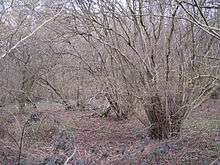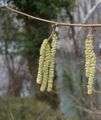Hazel
The hazel (Corylus) is a genus of deciduous trees and large shrubs native to the temperate Northern Hemisphere. The genus is usually placed in the birch family Betulaceae,[2][3][4][5] though some botanists split the hazels (with the hornbeams and allied genera) into a separate family Corylaceae.[6][7] The fruit of the hazel is the hazelnut.
| Hazels | |
|---|---|
| Common hazel (Corylus avellana) | |
| Scientific classification | |
| Kingdom: | Plantae |
| Clade: | Tracheophytes |
| Clade: | Angiosperms |
| Clade: | Eudicots |
| Clade: | Rosids |
| Order: | Fagales |
| Family: | Betulaceae |
| Subfamily: | Coryloideae |
| Genus: | Corylus L. |
| Synonyms[1] | |
|
Lopima Dochnahl | |
Hazels have simple, rounded leaves with double-serrate margins. The flowers are produced very early in spring before the leaves, and are monoecious, with single-sex catkins. The male catkins are pale yellow and 5–12 cm long, and the female ones are very small and largely concealed in the buds, with only the bright-red, 1-to-3 mm-long styles visible. The fruits are nuts 1–2.5 cm long and 1–2 cm diameter, surrounded by an involucre (husk) which partly to fully encloses the nut.[4]
The shape and structure of the involucre, and also the growth habit (whether a tree or a suckering shrub), are important in the identification of the different species of hazel.[4]
The pollen of hazel species, which are often the cause for allergies in late winter or early spring, can be identified under magnification (600X) by their characteristic granular exines bearing three conspicuous pores.[8]
Species
Corylus has 14–18 species. The circumscription of species in eastern Asia is disputed, with WCSP and the Flora of China differing in which taxa are accepted; within this region, only those taxa accepted by both sources are listed below.[4][9][10][11] The species are grouped as follows:
- Nut surrounded by a soft, leafy involucre, multiple-stemmed, suckering shrubs to 12 m tall
- Involucre short, about the same length as the nut
- Corylus americana – American hazel, eastern North America
- Corylus avellana – Common hazel, Europe and western Asia
- Corylus heterophylla – Asian hazel, Asia
- Corylus yunnanensis – Yunnan hazel, central and southern China
- Involucre long, twice the length of the nut or more, forming a 'beak'
- Corylus colchica – Colchican filbert, Caucasus
- Corylus cornuta – Beaked hazel, North America
- Corylus maxima – Filbert, southeastern Europe and southwest Asia
- Corylus sieboldiana – Asian beaked hazel, northeastern Asia and Japan (syn. C. mandshurica)
- Involucre short, about the same length as the nut
- Nut surrounded by a stiff, spiny involucre, single-stemmed trees to 20–35 m tall
- Involucre moderately spiny and also with glandular hairs
- Corylus chinensis – Chinese hazel, western China
- Corylus colurna – Turkish hazel, southeastern Europe and Asia Minor
- Corylus fargesii – Farges' hazel, western China
- Corylus jacquemontii – Jacquemont's hazel, Himalaya
- Corylus wangii – Wang's hazel, southwest China
- Involucre densely spiny, resembling a chestnut burr
- Corylus ferox – Himalayan hazel, Himalaya, Tibet and southwest China (syn. C. tibetica).
- Involucre moderately spiny and also with glandular hairs
Several hybrids exist, and can occur between species in different sections of the genus, e.g. Corylus × colurnoides (C. avellana × C. colurna). The oldest confirmed hazel species is Corylus johnsonii found as fossils in the Ypresian-age rocks of Ferry County, Washington.[12]
Uses

The nuts of all hazels are edible (see hazelnut). The common hazel is the species most extensively grown for its nuts, followed in importance by the filbert. Nuts are also harvested from the other species, but apart from the filbert, none is of significant commercial importance.[5]
A number of cultivars of the common hazel and filbert are grown as ornamental plants in gardens, including forms with contorted stems (C. avellana 'Contorta', popularly known as "Harry Lauder's walking stick" from its gnarled appearance); with weeping branches (C. avellana 'Pendula'); and with purple leaves (C. maxima 'Purpurea').
Hazel is a traditional material used for making wattle, withy fencing, baskets, and the frames of coracle boats. The tree can be coppiced, and regenerating shoots allow for harvests every few years.
Hazels are used as food plants by the larvae of various species of Lepidoptera.
Ecology
At least 21 species of fungus have a mutualistic relationship with hazel. Lactarius pyrogalus grows almost exclusively on hazel, and hazel is one of two kinds of host for the rare Hypocreposis rhododrendri. Several rare species of Graphidion lichen depend on hazel trees. In the UK, five species of moth are specialised to feed on hazel including Parornix devoniella. Animals which eat hazelnuts include red deer, dormouse and red squirrel.[13]
Mythology and folklore
The Celts believed hazelnuts gave one wisdom and inspiration. There are numerous variations on an ancient tale that nine hazel trees grew around a sacred pool, dropping into the water nuts that were eaten by salmon (a fish sacred to Druids), which absorbed the wisdom. A Druid teacher, in his bid to become omniscient, caught one of these special salmon and asked a student to cook the fish, but not to eat it. While he was cooking it, a blister formed and the pupil used his thumb to burst it, which he naturally sucked to cool, thereby absorbing the fish's wisdom. This boy was called Fionn Mac Cumhail (Fin McCool) and went on to become one of the most heroic leaders in Gaelic mythology.[14]
"The Hazel Branch" from Grimms' Fairy Tales claims that hazel branches offer the greatest protection from snakes and other things that creep on the earth.
Gallery
- Form (Farges' hazel)
 Male catkins (common hazel)
Male catkins (common hazel) Female flower (common hazel)
Female flower (common hazel) Leaves and nuts with spiny husks (Turkish hazel)
Leaves and nuts with spiny husks (Turkish hazel)
%2C_overlay_of_7_channel_autofluorescence_microscopy_(30458886372).jpg) Closeup of a male hazelnut flower using autofluorescence microscopy.
Closeup of a male hazelnut flower using autofluorescence microscopy.
References
- Kew World Checklist of Selected Plant Families
- Germplasm Resources Information Network: Corylus Archived 2009-01-14 at the Wayback Machine
- Chen, Zhi-Duan; Manchester, Steven R; Sun, Hai-Ying (August 1999). "Phylogeny and evolution of the Betulaceae as inferred from DNA sequences, morphology, and paleobotany". American Journal of Botany. 86 (8): 1168–1181. doi:10.2307/2656981. ISSN 0002-9122. JSTOR 2656981.
- Rushforth, K. (1999). Trees of Britain and Europe. Collins ISBN 0-00-220013-9.
- Huxley, A., ed. (1992). New RHS Dictionary of Gardening. Macmillan ISBN 0-333-47494-5.
- Bean, William Jackson (1976). Trees and Shrubs Hardy in the British Isles. 1. Taylor, George (8th ed.). London: J. Murray. ISBN 0719517907. OCLC 103403.
- Erdogan, V.; Mehlenbacher, S. A. (2002). "Phylogenetic analysis of hazelnut species (Corylus, Corylacae) based on morphology and phenology". Sist. Bot. Dergisi. 9: 83–100.
- Airy, Hubert (1874). "Pollen-grains in the Air". Nature. 10 (253): 355. doi:10.1038/010355b0.
- WCSP: Corylus
- Flora of China: Corylus
- Flora of North America: Corylus
- Pigg, K.B.; Manchester S.R.; Wehr W.C. (2003). "Corylus, Carpinus, and Palaeocarpinus (Betulaceae) from the Middle Eocene Klondike Mountain and Allenby Formations of Northwestern North America". International Journal of Plant Sciences. 164 (5): 807–822. doi:10.1086/376816.
- Trees for Life - Hazel
- Floriz: Mythology and Folklore of the Hazel Tree Archived 2012-03-31 at the Wayback Machine
External links
| Wikimedia Commons has media related to Corylus. |
- Eichhorn, Markus (December 2010). "The Hazel Tree". Test Tube. Brady Haran for the University of Nottingham.